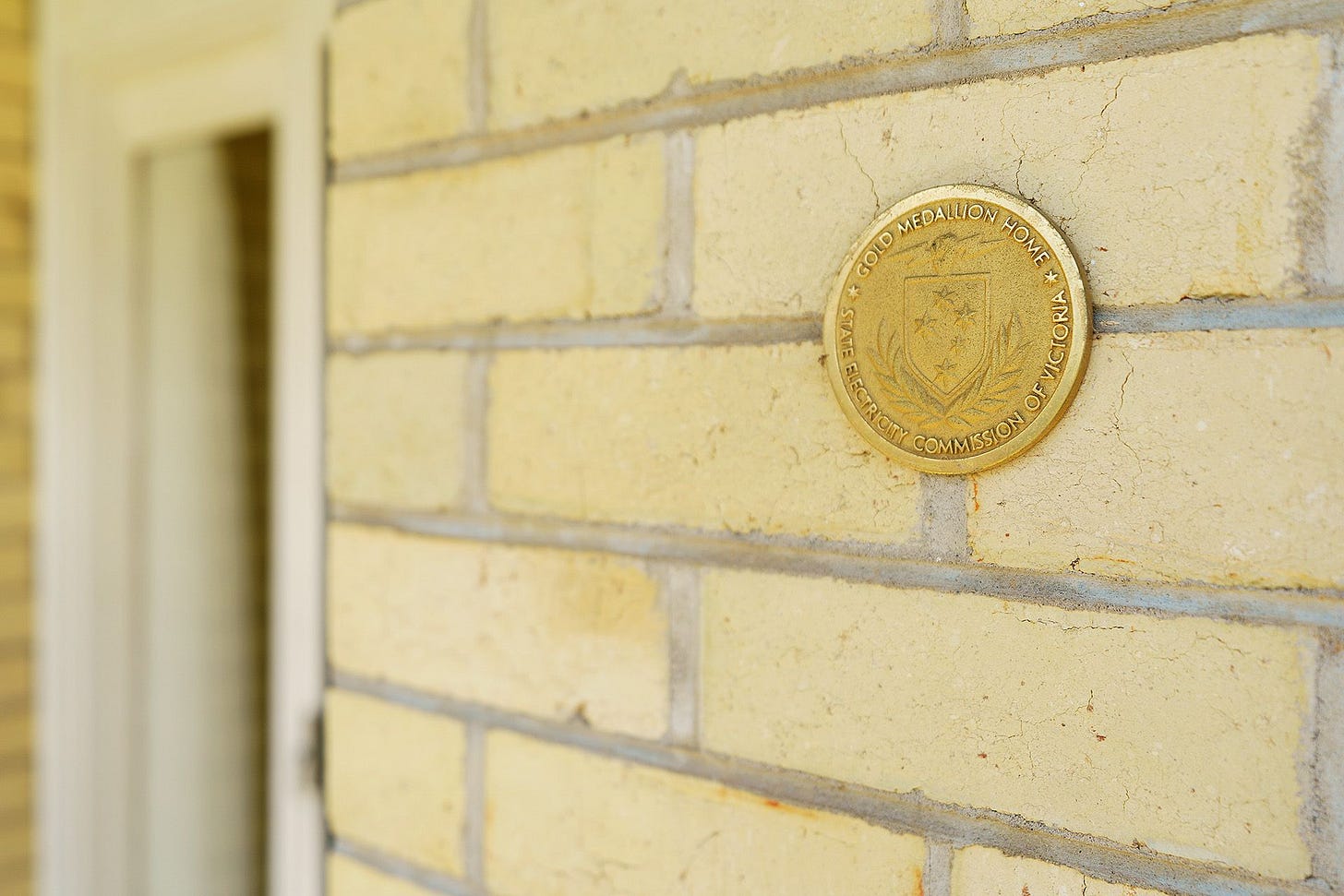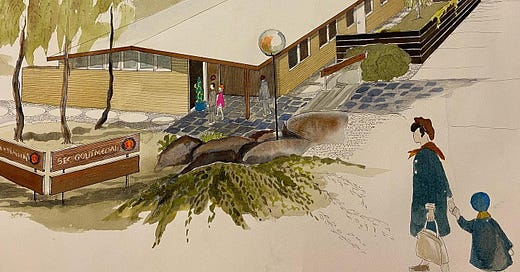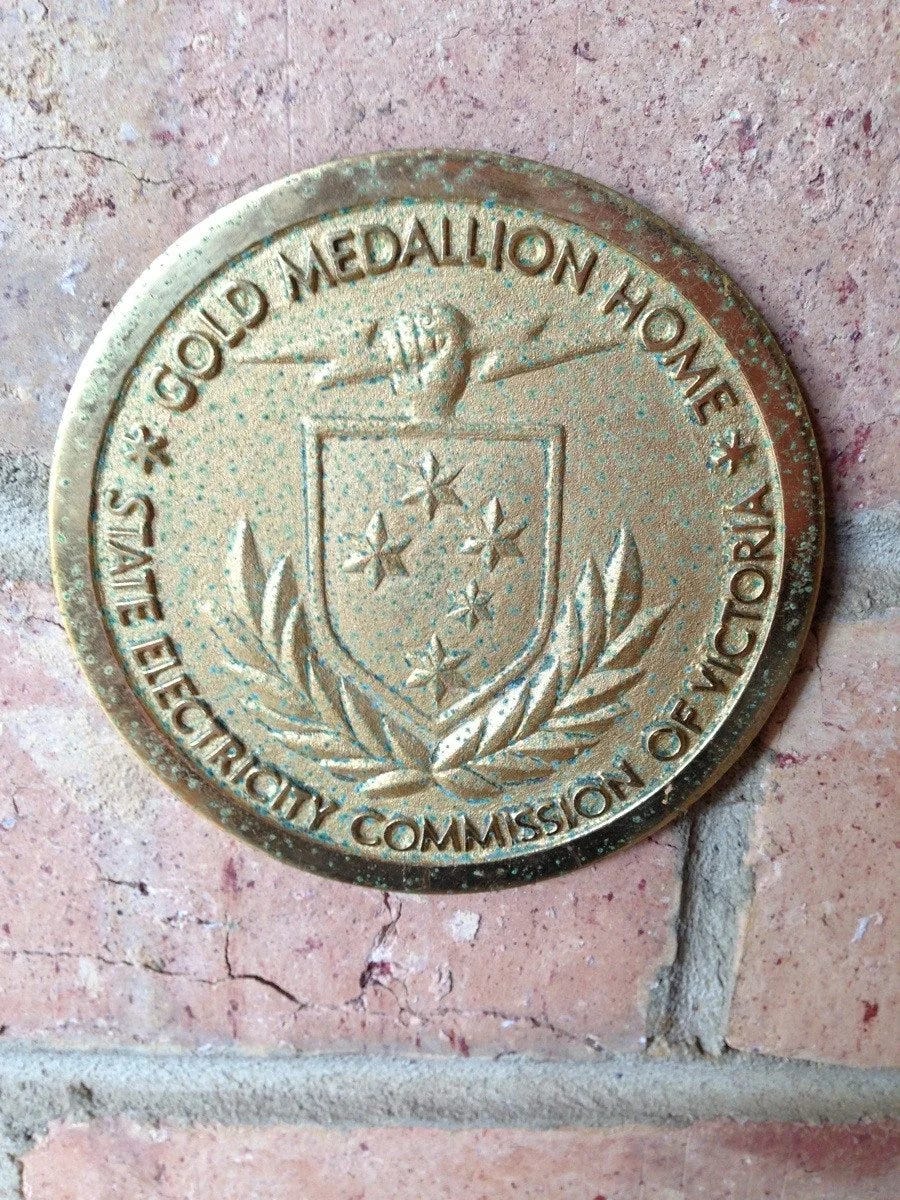Everything Old is New Again
Residential electrification might not be as new an idea as we think it is...
Not for the first time, this post might be too long to view in an email — mostly because it’s chock full of pictures. It’s easier to read (and the formatting seems to be better) if you read our posts on the Substack site or in the app.
I was perusing Marcus Wong's excellent blog Waking up in Geelong and I stumbled across this image.1 It's a picture of a circa 1960-70s advert from the side of a tram advertising an all-electric kitchen. Consider my interest piqued.
The idea of an all-electric home advert from 60 years ago seemed wild. And it gets wilder still.
The gold medallion program
The tram advert for the all-electric kitchen was part of a post-war push by the State Electricity Commission of Victoria to connect Victoria's homes to the electrical grid and provide a safer, cleaner cooking experience.
In 1950, the SECV provided electricity to only 391,000 residential and commercial customers (with a peak coincident demand of just 504 MW — compared to an average demand of around 5,000 MW now). Homes were heated with wood or coal (briquette) fires, likewise for kitchen stoves, which were not only rather inconvenient, but smoky and dangerous. The appeal of a modern electric stove from a safety perspective is obvious, not to mention the convenience of not having to relight fires daily.2
This mid-century push for electrification is obvious from a modernity and safety perspective, but what's interesting is that the SECV actively marketed and campaigned for electrification. Not only was the SECV actively focussed on marketing electricity usage, but in particular they encouraged the idea of “high load-factor and off-peak loads”.3 According to the SECV, this would:
“help to achieve a high energy growth through efficient use of generation, transmission and distribution assets”.
So as part of this push for rapid electrification, in August 1967 the SECV rolled out the Gold Medallion scheme — a promotional scheme which awarded a literal gold medallion to homes which were built to the most modern electrical standards.

So what qualified a home for one of these shiny little badges?
All-electric, obviously. But beyond that it was meant to represent the pinnacle of modern electrical standards. I can't find any definitive references to what being awarded a gold medallion actually entailed. I think it’s something along the lines of:
High quality wiring — houses designed with electrical installations from the outset or with capacity on the switchboard to handle the electrical loads of more modern electrical appliances, rather than older homes with poorly retrofitted, ad hoc or inconsistent installations.
Designed to support electric appliances — plenty of power points in every room, placed in convenient and logical locations.
Three phase (and possibly two phase) power — I'm less certain on this one, but this oral history project mentions it.
Declining electricity rates — A 1976 article from the Tribune, mentions that Gold Medallion homes were on declining blocks — use more than 525 kWh per quarter and you get a 19% reduction on the next block.4
I don't think underground distribution wiring to neighbourhoods was explicitly part of the program, but the SECV had a push for underground wiring in the suburbs during this same time, and it seems logical that newly developed estates with Gold Medallion homes would probably also have the tidy distribution connections.
Additionally, as mentioned in this article from the RMIT Design Archives (and elsewhere) the SECV even had a design advisory arm, employing architects to help design homes to the Gold Medallion standard and recommendations for the selection and operation of electric appliances.

Most modern mentions of the gold medallion scheme are oblique one liners — i.e. homes which strived to be all-electric were awarded a special little gold star for moral reasons. But in reality the scheme was a marketing ploy, concocted by a public utility seeking to expand its territory.
Although the energy system was public prior to the 1990s privatisation, the gas and electricity systems were operated by separate public utilities, because Utopia. The SECV ran the electricity system, and the Gas and Fuel Corporation of Victoria was responsible for the gas production and distribution system — initially coal gas, and then natural gas.
The SECV’s own recommendations for electrification were based not only on modernity, but also on increasing luxuries like air-conditioners, large fridges and clothes dryers. They were literally providing advice to purchase appliances which used more electricity.
It seems an unlikely coincidence that significant gas reserves were discovered in the Bass Strait in 1965, a clear sign of the what the future held…
Living Better Electrically
The SECV wasn't the only electric utility with this idea. In fact it's likely the SECV got the idea from the US.
There's no definitive source I can find which connects the SECV Gold Medallion scheme to the similar medallion schemes in US. But this article talks about the history of the “Live Better Electrically” and “Medallion Home” campaigns which began in the 1950s in the US. Much like the SECV's program, the programs in the US were initially driven by electric appliance manufacturers General Electric and Westinghouse, and were centred not just on suburban modernisation, but on an opposition to the competing natural gas networks and appliances.
There's even less information that I can find, but it also appears that in the 1970s the state electricity commissions of both NSW and Queensland also launched similar schemes to encourage efficient and modern electrical design for household, under the “Home Power Plus scheme”.
Such was the drive of the SECV’s marketing, this advertisement in a 1976 edition of the Canberra Times suggests that the Gold Medallion standard was being used outside of Victoria.

The death of all electric homes
It's easy to read the glossy annual reports of the SECV during the time of the Gold Medallion program and assume that electrification of homes was the modern path forward. History tells a different story.
Discovery of gas in the Bass Strait lead to a glut of cheap natural gas and a push to provide gas to as many homes in Victoria as possible. I don't know the precise fork in the road, or how it played out, but the result was that by the close of the twentieth century Victoria had a higher reliance on gas than any other Australian state, with some 3 million individual connections accounting for 65% of the country's [residential] gas consumption.
I can't find any mention of how many homes were ultimately awarded gold medallions or when the scheme was wrapped up, but the 1973 SECV Annual Report talks about the Gold Medallion program being successful and wildly adopted by display and project builders. Later annual reports I have copies of don't mention the scheme, but interestingly the Gold Medallion trademark was renewed in 1988, long after gas had won the residential energy wars.
The 1973 SECV Annual Report states the share of residential cooking and water heating from electricity was 53% and 56%, respectively — a clear sign of gas’ rapid residential rise.5
Everything old is new again
And yet, like a phoenix rising from the gas-fired ashes, all-electric homes are back baby!
The Victorian government has passed legislation banning gas connections for new residential homes beginning in 2024, so all new homes will be Gold Medallion homes!6 No plans have been announced for removing gas from existing homes, but with the Bass Strait reserves dwindling, and significantly rising costs, it is only a matter of time before governments or consumers start replacing gas with electricity.
Despite the fact that Gold Medallion program likely died a quiet death in the 1980s, it leaves a legacy of more than just the little plaques on suburban homes. It set a modern standard of electrical design that is easy to take for granted in the twenty-first century — homes with a not just an abundance of power outlets, but outlets located in logical and convenient locations. Electrical wiring standards of high quality, with future capacity expansion in mind. And for better or worse the encouragement of high-electricity consumption (previously) luxury appliances.
While we're on the topic of seeming radical changes our society is currently undergoing, the 1975 SECV annual report calls out both solar energy (in the form of solar water heating) and electric cars. These ideas and changes are not so radical to people in the industry!
The electrification of the state during the twentieth century was undoubtedly a good thing, but we should be careful not to convince ourselves that the SECV Gold Medallion scheme was some kind of noble environmental scheme or draw too many parallels to the contemporary drivers of residential electrification.
Things Happen
Not strictly energy related, but the Tillies are through to the semis on the way to win the World Cup. Let’s goooo!!
Japanese backers of Australian hydrogen are asking for greater Australian taxpayer support for incredibly dirty hydrogen with carbon capture and storage tacked on. Hopefully the lobbying doesn’t work, and the money can be directed into climate solutions that actually work.
Barnaby Joyce convened the Nats to put forward nuclear power as the solution for the farmers and miners they represent. Don’t worry about climate change or losing mining jobs, because your MP is throwing weight behind an unproven, expensive energy solution. Also, the Nats would oppose a public holiday if the Matildas win — says it all.
Meme of the Week
We’re trying out a new thing! Each week we’ll post our favourite energy meme. We’re adept at making our own, but we wanna see what you can come up with! Send your best submissions to currentlyspeaking@substack.com, and we’ll post it up with a call out (or anonymously).
He writes a blog on trains, power systems, history and everything in between. It's very good, very nerdy and if you like this newsletter you'll probably enjoy his blog.
The middle of the twentieth century saw rapid electrification of the extra-metropolitan and regional areas, as well as farms (rural). Electrification of all homes in the state of Victoria wasn't completed until around 1970, which is not that long ago!
Quotes from the 1973 SECV Annual Report.
This article is savagely critical of the entire scheme and the marketing tactics used by the SECV to drive electricity consumption and growth.
Not all of the competition would have been natural gas — there would have been people still using wood or coal, as well as LPG which was a another battlefront the Gas and Fuel Corporation was fighting.
Worth noting that LPG connections are exempted, so if you really, really love gas, you can still get it. Or maybe you think hydrogen appliances will be a thing 🤷










Inciteful and amusing as always Alex, thanks for sharing legend!
Love your work Alex. Brilliant!